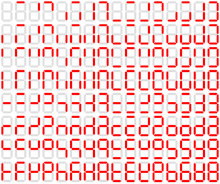| ||||
|---|---|---|---|---|
| Cardinal | one hundred twenty-eight | |||
| Ordinal | 128th (one hundred twenty-eighth) | |||
| Factorization | 27 | |||
| Divisors | 1, 2, 4, 8, 16, 32, 64, 128 | |||
| Greek numeral | ΡΚΗ´ | |||
| Roman numeral | CXXVIII | |||
| Binary | 100000002 | |||
| Ternary | 112023 | |||
| Senary | 3326 | |||
| Octal | 2008 | |||
| Duodecimal | A812 | |||
| Hexadecimal | 8016 | |||
128 (one hundred [and] twenty-eight) is the natural number following 127 and preceding 129.
In mathematics
128 is the seventh power of 2. It is the largest number which cannot be expressed as the sum of any number of distinct squares. [1] [2] However, it is divisible by the total number of its divisors, making it a refactorable number. [3]
The sum of Euler's totient function φ(x) over the first twenty integers is 128. [4]
128 can be expressed by a combination of its digits with mathematical operators, thus 128 = 28 − 1, making it a Friedman number in base 10. [5]
128 is the only 3-digit number that is a 7th power (27).
In bar codes
- Code 128 is a Uniform Symbology Specification (USS Code 128) alphanumeric bar code that encodes text, numbers, numerous functions, and designed to encode all 128 ASCII characters (ASCII 0 to ASCII 127), as used in the shipping industry.
- Subdivisions include:
- 128A (0–9, A–Z, ASCII control codes, special characters)
- 128B (0–9, A–Z, a–z, special characters)
- 128C (00–99 numeric characters)
- GS1-128 application standard of the GS1 implementation using the Code 128 barcode specification
- ISBT 128 system for blood product labeling for the International Society of Blood Transfusion
In computing
- 128-bit key size encryption for secure communications over the Internet

- Seven-segment displays have 128 possible states.
- ASCII includes definitions for 128 characters (33 non-printing characters, mostly obsolete control characters that affect how text is processed, and 94 printable)
- A 128-bit integer can represent up to 3.40282366...e+38 values (2128 = 340,282,366,920,938,463,463,374,607,431,768,211,456).
- CAST-128 is a block cipher used in a number of products, notably as the default cipher in some versions of GPG and PGP.
- Graphics cards have a 128-bit, 256-bit, or 512-bit data bus to memory.
- Atari 2600 consoles have 128 bytes of memory
- Sony's PlayStation 2 Emotion Engine CPU has two 128-bit vector units
- Macintosh 128K, the original Apple Macintosh personal computer released in 1984
- Laser 128, a clone of the Apple II released in 1984
- Commodore 128, a home/personal computer which had a 128 KB of memory released in 1985
- Enterprise 128 Zilog Z80, a home computer released in 1985
- Jane 128, a GUI-based integrated software package for the Commodore 128 personal computer released in 1985
- RIVA 128 (Real-time Interactive Video and Animation accelerator), one of the first consumer graphics chips to integrate 3D and video acceleration in 1997
- Super Mario 128, a cancelled Nintendo game, though many elements were included in Super Mario Galaxy and Pikmin
In the military
- USNS Mission San Luis Rey (T-AO-128), a United States Navy Mission Buenaventura-class fleet oilers during World War II
- USS Arenac (APA-128), a United States Navy Haskell-class attack transport during World War II
- USS Cavallaro (APD-128), a United States Navy Crosley-class high speed transport
- USS Leonis (AK-128), a United States Navy Crater-class cargo ship during World War II
- USS Velocity (AM-128), a United States Navy Auk-class minesweeper which removed naval mines laid in the water
In transportation
- Fiat 128, a small car manufactured by Fiat from 1969 to 1985.
- SEAT 128, a 2-door coupe version of the Fiat 128
- The BMW 128i convertible
- 128 is the number of many roads, including Massachusetts Route 128, Boston's inner beltway.
- Route 128 Station is a stop on the Massachusetts Bay Transportation Authority Attleboro/ Providence MBTA Commuter Rail line in Westwood, Massachusetts
- STS-128 was a Space Shuttle Discovery mission to the International Space Station in 2009
In other fields
One hundred [and] twenty-eight is also:
- The year AD 128 or 128 BC
- 128 AH, a year in the Islamic calendar that corresponds to 745 – 746 CE
- 128 Nemesis, a main-belt asteroid
- Ross 128, a red dwarf star, the eleventh closest star system to the Solar System
- 128P/Shoemaker-Holt, a periodic comet in the Solar system
- The atomic number of unbioctium, an element yet to be discovered
- The number of musical instruments specified in General MIDI. Sometimes they are numbered 0 to 127 and sometimes they are numbered 1 to 128
- 128 film, a film format
- Sonnet 128 by William Shakespeare
- In music, a hundred twenty-eighth note is a note played for 1/128 of the duration of a whole note
- The number of US fluid ounces in a US gallon
See also
Notes
- ^ Sprague, R. (1948), "Über Zerlegungen in ungleiche Quadratzahlen", Math. Z., 51 (3): 289–290, doi: 10.1007/BF01181594, MR 0027285, S2CID 123515191
- ^ OEIS:A001422. Similarly, the largest numbers that cannot be expressed as sums of distinct cubes and fourth powers, respectively, are 12758 and 5134240 (sequence A001661 in the OEIS).
- ^ OEIS:A033950.
- ^ OEIS:A002088.
- ^ OEIS:A036057.
References
- Wells, D. The Penguin Dictionary of Curious and Interesting Numbers London: Penguin Group. (1987): 138
External links
Wikimedia Commons has media related to
128 (number).